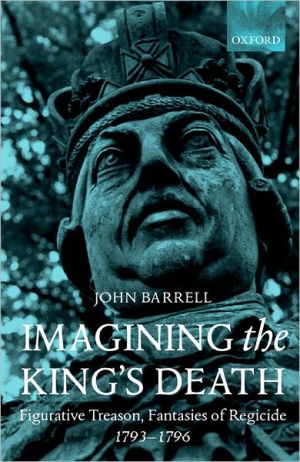

 |

|

The average rating for Imagining the King's Death: Figurative Treason, Fantasies of Regicide, 1793-1796 based on 2 reviews is 3.5 stars.
Review # 1 was written on 2009-05-21 00:00:00 John M Alo John M AloThis book is rather fascinating if you are interested in the 18th century but overall I found this book to be a difficult read. I really dont have much to show for the finished product of this book. |
Review # 2 was written on 2016-06-24 00:00:00 James Long James LongThis book reveals how literature, mythology, and Lewis' life influenced The Chronicles of Narnia. It also explores spiritual and moral lessons. I especially liked the chapters "Classical and Medieval Elements" and "What's in a Narnian Name?" I read this because it was referenced in Inside The Voyage of the Dawn Treader by Devin Brown. In my notes below, quotes are from the author, unless I say they're from Lewis. Emeth Emeth's salvation is explained by Lewis' inclusivist view: "… that Christ's reconciling work may sometimes apply even to those who are not aware of it. Lewis did not feel that he was being unorthodox in this matter. He refers several times in his letters to Christ's portrayal of judgement in which he welcomes those who fed the hungry, clothed the naked, and visited the sick, saying that all such service done for the least of his brethren is accounted as service done to him."In a 1952 letter, Lewis said, "I think every prayer which is sincerely made, even to a false god … is accepted by the true God, and that Christ saves many who do not think they know him." Moral Psychology Lewis preferred simple, old-fashioned things, and complained about preoccupation with luxury and technology. In the Chronicles, it's the evil characters who are always thinking about tech and industrial development (Uncle Andrew, Edmund while with the Witch, Shift the Ape). When a reader asked about the fate of the feasting squirrels in Lion, Lewis answered that they were returned to normal when Aslan rescued the others who had been stone. Classical and Medieval Elements "Lewis's whole person was drawn to a time when Western civilization could with some accuracy be called Christendom and when a predominant literary form was epic romance. The world of Aquinas and King Arthur, of Boethius and Beowulf."Lewis included pagan mythological elements in his stories because Lewis believed that the noblest classical myths represented "a real though unfocused gleam of divine truth falling on human imagination" (Lewis). "Lewis noted with approval how medieval and Elizabethan authors freely mixed classical and Christian elements in their creative works." Lewis used archaic language to contribute to the atmosphere of medieval romance. Lewis didn't believe in astrology, but he found it imaginatively attractive. It encourages humility (forces of nature control us more than we control them), and movement of planets and stars confirms cosmic order. What's in a Narnian Name? Word "frank" originally referred to a French nobleman in England. In Middle Ages, frankness suggested the aristocratic ideals of gentleness, courtesy, honesty. "Puddleglum" comes from a 16th century poet who described the river Styx as a "puddle glum." Jewel is named after an Anglican cleric whose heart was good but who was too easily drawn into rash controversies. Dr. Cornelius is named after Cornelius Agrippa, a 15th century Christian scholar who believed one could practice a certain amount of white magic without danger to one's soul. The green kirtle was inspired by the kirtle and green sash in Sir Gawain and the Green Knight. For names of good characters and places, Lewis used liquids and nasals, which have musical, soft tones. For bad characters and places, he used dissonant-sounding names with fricatives and plosives, which sound prosaic and harsh. Roonwit has the "wit" to read "roons" (runes). Lewis' Literary Artistry It's usually negative lame characters who make sexist remarks. Tash isn't a demonization of Islam; he's modeled on Middle Eastern Efreets (demons). The objectionable traits of the Calormenes come from Lewis' source materials, which arose among Middle Easterners, not outsiders. There are several anti-racist passages in the Chronicles. Definitions, Allusions, and Textual Notes Mice nibbling Aslan's cords: allusion to one of Aesop's fables. White stag: Celtic lore includes a white stag who grants one wish to those who catch him. Bridge Builder: translation of Pontifex Maximus, a Roman official in charge of bridges. Early Christians called Christ "the Pontifex" because he built a bridge between humans and God, mortality and immortality. Salamanders in fire: medieval texts speak of gnomes in the earth and salamanders in fire. Tirian and Jewel's rage: echoes Moses striking down and Egyptian slavemaster. |
CAN'T FIND WHAT YOU'RE LOOKING FOR? CLICK HERE!!!